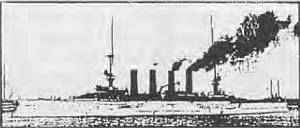- Author
- Jarrett, Hugh
- Subjects
- WWI operations, RAN operations
- Tags
-
- RAN Ships
- HMAS Melbourne I, HMAS Sydney I, HMAS Australia I, HMAS Pioneer, HMAS Encounter I
- Publication
- July 1992 edition of the Naval Historical Review (all rights reserved)
Accordingly, he sailed with HMSs MINOTAUR, HAMPSHIRE and NEWCASTLE from Hong Kong on 6th August for Yap, leaving HMS YARMOUTH and the French cruiser DUPLEIX to await the battleship, HMS TRIUMPH, and then proceed to the Saddle Island to cover Tsing-tao.
The crew of TRIUMPH had been brought up to strength with 100 soldiers from the 2nd Battalion, Duke of Cornwall’s Light Infantry!
On the 5th August, Vice-Admiral Graf von Spee signalled EMDEN, ordering her to ‘detach’ and wished her luck.
Admiral Jerram was on his way to Yap and was observing wireless silence to avoid disclosing his movements. On 9th August AUSTRALIA was heard calling but no reply was made. Rear Admiral Patey in AUSTRALIA wanted to suggest a concentration of forces.
The Australian Squadron
On 30th July 1914, the Government of Australia placed their naval forces at the disposal of the British Admiralty, the Commonwealth Naval Board assuming the status of a Commander-in-Chief ashore. On 4th August 1914, the distribution of the Australian Squadron and its intended movements were as follows:
AUSTRALIA: At Sydney. To leave for Hong Kong via Albany W.A. Rear Admiral Patey to shift his flag to HMAS ENCOUNTER.
MELBOURNE: Left Sydney for Fremantle.
ENCOUNTER: At Sydney.
PIONEER: At Sydney.
PARRAMATTA: Left Sydney for Thursday Island.
SYDNEY:
WARREGO: Left Townsville for Thursday Island.
YARRA:
Submarine AE1 and Submarine AE2: At Sydney refitting after arriving from UK. Both boats were completed in record time, being completed by 10th August.
Based at Auckland was the NZ Division comprising the old cruisers:
PSYCHE: Proceeding to Suva.
PHILOMEL: Proceeding to New Hebrides.
PYRAMUS: Proceeding to the Tonga Islands.
The intelligence available to Admiral Patey on 4th August was vague and inaccurate. He assessed it as:

(SMSM GNEISENAU sister ship)
SCHARNHORST – Position unknown
GNEISENAU – Left Nagasaki, Japan, 23rd June. Probably with SCHARNHORST.
NURNBERG – Possibly on her way from Mazatlan, Mexico, to go to Tsing-tao.
LEIPZIG: Off Vancouver.
Early Intelligence and Admiral Patey’s Appreciation
On 1st August (before hostilities commenced) the Yap W/T station had been heard trying to raise SCHARNHORST. On 2nd August S.S. TANNENFELS left Singapore with 6,000 tons of coal without clearance from the port authority. Two German colliers had cleared Newcastle, NSW, in a hurry, under sealed orders, steering north-east. On 3rd August W/T stations in North Australia intercepted signals that indicated SCHARNHORST, GNEISENAU and other German ships were near New Guinea and SCHARNHORST was communicating with Yap.
From these clues, Rear Admiral Patey judged that von Spee was endeavouring to concentrate his force in the neighbourhood of New Guinea or the Bismarck Archipelago, where he had two good harbours available to him. These were Freidrich Wilhelmshafen (Madang) and Simpsonhafen with the town of Herbertshohe (Rabaul), where, it was reported, a W/T station had recently been completed at Kakabaul.
This constituted a direct threat to Australian waters not foreseen in Standing War Orders. Consequently Admiral Patey suggested that all available RAN ships concentrate off Port Moresby to cover the north-eastern approaches to Australia and to bring the enemy to battle if possible.
The Admiralty approved his plan.
His preliminary plan was to cover the approaches to Australia, reconnoitre the German bases and search the Bismarck Archipelago.
He shared the view with Vice-Admiral Jerram, C-in-C China Station, that it was unsound to proceed into the wide expanses of the Pacific Ocean to seek an unlocated enemy. The strategies of the two admirals were devoted, initially, to protecting the trade routes and destroying the German communications and supplies.

On 4th August, HMAS AUSTRALIA sailed from Sydney flying the flag of Rear Admiral Patey. It was his intention to concentrate the HMA Ships AUSTRALIA, SYDNEY, ENCOUNTER and three destroyers, and if there was no news of the enemy ships to proceed to Simpsonhafen where he suspected he might find German ships.
On 6th August he received word that W/T indications were that SCHARNHORST, GNEISENAU and NURNBERG were near the Solomon Islands steering south-Baste. He considered this was too indefinite to make him change his plans.
The First Simpsonhafen Operation
HMAS MELBOURNE had been despatched to Fremantle to protect the trade routes and deal with any German cruiser in the area. This was considered now less likely and the old cruiser HMAS PIONEER, was sent to replace her. MELBOURNE was recalled to rejoin the fleet in New Guinea waters, but did not arrive in time to take part in the first operation.




